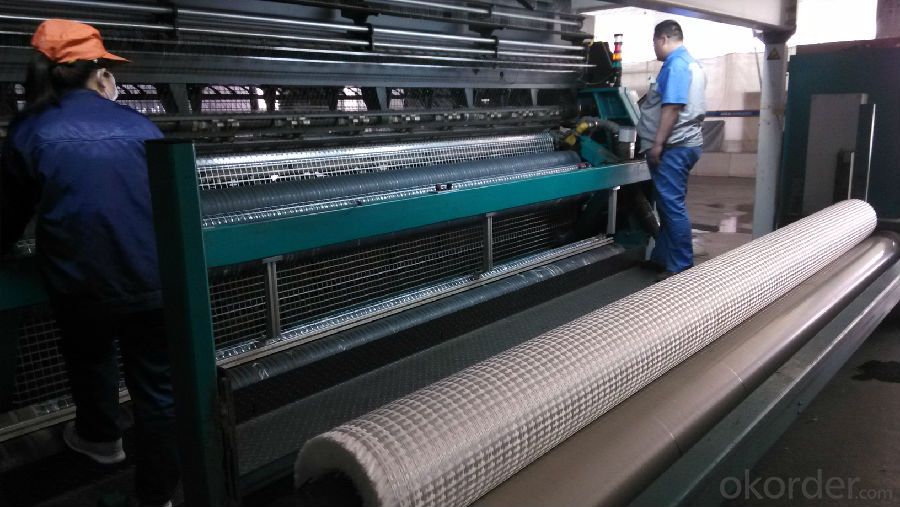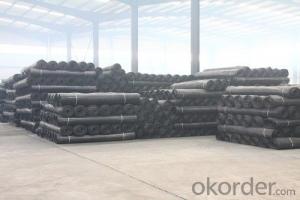Fiberglass geogrid for River Bank- Hot sell
- Loading Port:
- Qingdao
- Payment Terms:
- TT OR LC
- Min Order Qty:
- 1000 m²
- Supply Capability:
- 1000000 m²/month
OKorder Service Pledge
OKorder Financial Service
You Might Also Like
1.Brief Introduction
Product has high strength, low elongation, high temperature, high modulus , light weight , good toughness, corrosion resistance , long life , etc. , can be widely used in the old concrete pavement , maintenance of airport runways , dams , river banks , while slope protection , road bridge , enhancement engineering field, to the road surface can be enhanced , reinforced to prevent pavement rutting fatigue crack , hot and cold telescopic cracks and reflection cracks below , and can the pavement load stress dispersion , extending pavement life .
2.Characteristics
The high tensile strength low - elongation : Fiberglass geogrid is a glass fiber , while the high tensile strength of glass fiber , more than other fibers and ordinary metals . Its high modulus , high resistance to deformation , elongation at break of less than 3% .
No long-term creep : as a reinforcing material , with the ability to resist deformation under the load in the long-term creep resistance is extremely important, the glass fiber will not creep , to ensure that the products can long-term performance .
3.Application
ysical and chemical stability after special treatment agent coated handle , fiberglass geogrid to resist a variety of physical wear and chemical attack , but also to resist biological erosion and climate change to ensure that its performance is unaffected by the loss .
4.FAQ
good thermal stability : the melting point of glass fibers is above 1000 °C , to ensure the stability of the glass fiber geogrids to withstand high temperature in a paving job .

- Q:What are the different applications of fiberglass fabric in the oil and gas industry?
- Fiberglass fabric finds various applications in the oil and gas industry due to its excellent properties such as high strength, corrosion resistance, and thermal insulation. It is commonly used for insulation, fireproofing, and reinforcement purposes in pipelines, tanks, and equipment. Fiberglass fabric is also utilized for manufacturing composite materials in the form of pipes, gratings, and platforms, providing durability and resistance to chemicals and harsh environments. Overall, its versatility and reliability make it an essential material for enhancing safety and performance in the oil and gas sector.
- Q:Can fiberglass fabric be used for heat-resistant blankets?
- Indeed, heat-resistant blankets can be made using fiberglass fabric. Fiberglass, a remarkably heat-resistant substance, has the ability to endure high temperatures without any signs of melting or deterioration. Its exceptional thermal insulation qualities make it an optimal selection for heat-resistant blankets. Fiberglass fabric blankets have diverse applications, including welding, foundries, fire protection, and heat shielding. These blankets deliver dependable defense against heat, flames, and sparks, making them a trustworthy option for environments where heat resistance is of utmost importance.
- Q:How is fiberglass fabric used in the fashion industry?
- Fiberglass fabric is not commonly used in the fashion industry. However, it can be occasionally utilized in avant-garde or experimental fashion designs for its unique properties such as durability, strength, and transparency. In such cases, it may be incorporated into clothing, accessories, or even as a structural element in runway shows.
- Q:How is fiberglass fabric used in the production of composites?
- Industries such as aerospace, automotive, construction, and marine rely on fiberglass fabric as a critical component in the production of composites. Composites are materials formed by combining different components, with fiberglass fabric being a commonly used reinforcing material. During the production process, fiberglass fabric is typically mixed with a matrix material, like resin, to create a composite structure. The fabric itself consists of thin strands of glass fibers woven together to form a flexible and strong fabric. These glass fibers provide reinforcement and strength to the composite material, making it highly durable and resistant to external forces. One of the main advantages of using fiberglass fabric in composites is its excellent tensile strength. The woven fabric structure ensures even distribution of the load across the composite material, enabling it to withstand high levels of stress and prevent cracks or fractures. This property proves particularly beneficial in applications that require lightweight yet strong materials. Furthermore, fiberglass fabric exhibits exceptional resistance to corrosion, chemicals, and extreme temperatures. This makes composites reinforced with fiberglass fabric suitable for use in harsh environments where traditional materials may fail. For instance, fiberglass composites are commonly employed in aircraft and boat construction due to their ability to withstand the corrosive effects of saltwater and harsh weather conditions. Fiberglass fabric is also highly versatile and can be tailored to meet specific requirements. Manufacturers can produce it in different thicknesses, weaves, and finishes, allowing customization to suit desired applications. Additionally, it can be combined with other reinforcing materials, like carbon fiber or kevlar, to create hybrid composites with unique properties. In conclusion, fiberglass fabric plays a vital role in the production of composites, providing strength, durability, and resistance to environmental factors. Its versatility and customizability make it a preferred choice for various industries in need of lightweight yet robust materials.
- Q:Are there any specific certifications or standards for fiberglass fabrics?
- Yes, there are specific certifications and standards for fiberglass fabrics. One of the most widely recognized certifications for fiberglass fabrics is the ISO 9001:2015 certification, which signifies that the manufacturer has implemented a quality management system and meets the international standards for product quality. In addition, there are specific standards developed by organizations like ASTM International (formerly known as the American Society for Testing and Materials) that outline the testing methods and performance requirements for fiberglass fabrics. For example, ASTM D579-67(2013) provides standard specifications for glass fiber fabrics, while ASTM D3774-16a covers the testing of woven fabrics. Furthermore, there are industry-specific certifications that fiberglass fabric manufacturers may seek, such as the NORSOK M-710 certification for offshore applications or the MIL-STD-810 certification for military-grade fabrics. These certifications and standards help ensure that fiberglass fabrics meet certain quality, safety, and performance criteria. They provide customers with confidence in the product's reliability and help manufacturers demonstrate their commitment to producing high-quality fiberglass fabrics.
- Q:How is fiberglass fabric used in the production of electrical insulation tapes?
- Fiberglass fabric is used in the production of electrical insulation tapes because it has excellent electrical insulation properties and heat resistance. It is often used as a base material in these tapes to provide a protective layer that helps prevent electrical current from escaping or causing short circuits. Fiberglass fabric also adds strength and durability to the tape, allowing it to withstand high temperatures and harsh environments.
- Q:Is fiberglass fabric suitable for making car covers?
- Yes, fiberglass fabric is suitable for making car covers. Fiberglass fabric is a popular choice for car covers because it offers several advantages. Firstly, fiberglass fabric is highly durable and can withstand harsh weather conditions, including rain, snow, and UV rays from the sun. This ensures that the car remains protected and prevents any damage to the paint or interior. Additionally, fiberglass fabric is lightweight and easy to handle, making it convenient for covering and uncovering the car. It is also resistant to mildew and mold, which is crucial for maintaining the car's cleanliness and preventing any unwanted odors. Furthermore, fiberglass fabric is breathable, allowing moisture to escape and preventing the formation of condensation on the car's surface. Overall, fiberglass fabric is a reliable and effective choice for making car covers, providing excellent protection and ensuring the longevity of the vehicle.
- Q:What is the maximum width available for fiberglass fabric rolls?
- The maximum width available for fiberglass fabric rolls can vary depending on the manufacturer and specific product. However, in general, fiberglass fabric rolls typically come in widths ranging from 36 inches to 120 inches. These widths allow for a wide range of applications, from smaller projects to larger industrial applications. It's always best to check with the manufacturer or supplier for the specific maximum width options they have available for their fiberglass fabric rolls.
- Q:What is the typical lead time for ordering fiberglass fabrics?
- The typical lead time for ordering fiberglass fabrics can vary depending on several factors. Generally, it can range from a few days to a few weeks. The first factor that affects lead time is the availability of the specific fiberglass fabric you are looking for. Some types of fiberglass fabrics may be readily available in stock, while others may need to be manufactured or imported, which can add extra time to the lead time. Another factor is the quantity of fiberglass fabric you are ordering. Larger orders may require additional time for production and processing, especially if the fabric needs to be customized or cut to specific dimensions. Additionally, the location of the supplier can impact lead time. If the supplier is located far away from your location, it may take longer for the fabrics to be shipped and delivered. It is also important to consider any potential delays that can occur during the shipping process, such as customs clearance or unexpected transportation issues. To get a more accurate estimate of the lead time for ordering fiberglass fabrics, it is recommended to contact the supplier directly. They will be able to provide specific information based on their inventory, production capabilities, and shipping options.
- Q:What's the best form of roof waterproof?
- If it is inclined roof, with chimney or straight vent, it is recommended that the chimney around to focus on waterproof treatment. In addition to the use of ordinary cement base, do not use aluminum foil like asphalt, suggested above neutral weatherproof sealant coating, it can keep a long time waterproof! Personal experience.
1. Manufacturer Overview |
|
|---|---|
| Location | |
| Year Established | |
| Annual Output Value | |
| Main Markets | |
| Company Certifications | |
2. Manufacturer Certificates |
|
|---|---|
| a) Certification Name | |
| Range | |
| Reference | |
| Validity Period | |
3. Manufacturer Capability |
|
|---|---|
| a)Trade Capacity | |
| Nearest Port | |
| Export Percentage | |
| No.of Employees in Trade Department | |
| Language Spoken: | |
| b)Factory Information | |
| Factory Size: | |
| No. of Production Lines | |
| Contract Manufacturing | |
| Product Price Range | |
Send your message to us
Fiberglass geogrid for River Bank- Hot sell
- Loading Port:
- Qingdao
- Payment Terms:
- TT OR LC
- Min Order Qty:
- 1000 m²
- Supply Capability:
- 1000000 m²/month
OKorder Service Pledge
OKorder Financial Service
Similar products
New products
Hot products
Hot Searches
Related keywords





























